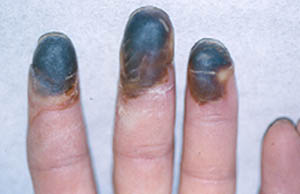Buerger’s Disease Causes, Symptoms, Diagnosis and Treatment

What Is Buerger’s Disease?
Buerger’s disease also known as thromboangiitis obliterans, is a rare disorder that, in most cases, affects young or middle-aged male cigarette smokers.
It is characterized by narrowing or blockage (occlusion) of the veins and arteries of the extremities, resulting in reduced blood flow to these areas (peripheral vascular disease).
The legs are affected more often than the arms. In most cases, the first symptom is extreme pain of the lower arms and legs while at rest.
Virtually everyone diagnosed with Buerger’s disease smokes cigarettes or uses other forms of tobacco, such as chewing tobacco.
Quitting all forms of tobacco is the only way to stop Buerger’s disease. For those who don’t quit, amputation of all or part of a limb may be necessary.
Buerger’s syndrome may lead to gangrene. Signs and symptoms of gangrene include black or blue skin, a loss of feeling in the affected finger or toe, and a foul smell from the affected area. Gangrene is a serious condition that usually requires amputation of the affected finger or toe.
Causes Of Buerger’s Disease:
It isn’t clear what triggers Buerger’s disease. It’s possible that some people may have a genetic predisposition to the disease.
Buerger’s disease is caused by small blood vessels that become inflamed and swollen.
Risk Factors Of Buerger’s Disease:
- Tobacco use
- Chronic gum disease
Symptoms Of Buerger’s Disease:
Symptoms most often affect 2 or more limbs and may include:
- Fingers or toes that appear pale, red, or bluish and feel cold to the touch.
- Sudden severe pain in the hands and feet. The pain may feel like a burning or tingling.
- Pain in the hands and feet that most often occurs when at rest. The pain may be worse when the hands and feet get cold or during emotional stress.
- Pain in the legs, ankles, or feet when walking (intermittent claudication). The pain is often located in the arch of the foot.
- Skin changes or small painful ulcers on the fingers or toes.
Diagnosis Of Buerger’s Disease:
There are no tests which confirm Buerger’s disease.
However, different tests can rule out other more common conditions or confirm suspicion of Buerger’s disease brought on by the onset signs and symptoms.
Tests may include:
- Blood test, to rule out other conditions that may cause similar signs and symptoms.
- Allen’s test, to check blood flow through the arteries carrying blood to the hands.
- Angiogram, to detect early signs of vessel damage
Treatment Of Buerger’s Disease:
Although no treatment can cure Buerger’s disease, the most effective way to halt the disease’s progress is to quit using all tobacco products.
This can be done via medications or residential smoking cessation programs.
Although less effective, other options do exist. Options include:
- Medications to dilate blood vessels, improve blood flow or dissolve blood clots
- Intermittent compression of the arms and legs to increase blood flow to the extremities.
- Spinal cord stimulation.
- Surgery to cut the nerves to the affected area (surgical sympathectomy) to control pain and increase blood flow.
- Medications to stimulate growth of new blood vessels (therapeutic angiogenesis),
- Amputation, if infection or gangrene occurs
Related Articles:
Bursitis Causes, Symptoms, Diagnosis and Treatment
Folliculitis Causes, Symptoms, Diagnosis and Treatment
Carcinoid Syndrome Causes, Symptoms, Diagnosis and Treatment
Shingles Symptoms, Causes, Diagnosis and Treatment
Chilblains Causes, Symptoms, Diagnosis and Treatment
Cradle Cap Causes, Symptoms, Diagnosis and Treatment
Contact Dermatitis Causes, Symptoms, Diagnosis and Treatment
Cold Urticaria Causes, Symptoms, Diagnosis and Treatment
Henoch Schonlein Purpura (HSP) Causes, Symptoms, Diagnosis and Treatment
Soft Tissue Sarcoma Causes, Symptoms, Diagnosis and Treatment
Pilonidal Cyst Causes, Symptoms, Diagnosis and Treatment
Stevens-Johnson Syndrome Causes, Symptoms, Diagnosis and Treatment
By : Natural Health News




